Floating wind prototype readies for Canary Islands deployment

X1 Wind is preparing to deploy its new PivotBuoy floating wind technology in the Canary Islands after successfully completing the assembly and load-out of a fully-functional prototype.
The prototype has been developed through the €4m PivotBuoy Project awarded by the European Commission H2020 Program.
It will be installed at the PLOCAN test site with full exposure to open ocean conditions in a bid to demonstrate the efficiency of the structural design and mooring system.
The Pivotbuoy Project is aiming to substantially reduce the current levelized cost Of electricity (LCOE) of floating wind by demonstrating the advantages of the PivotBuoy system, namely a reduced floater weight, a faster and cheaper installation process and a more reliable operation.
Fitted with a Vestas V29 turbine, the 1:3 scale prototype (X30) will be stationed at a 50 m water depth through a single point mooring system in a downwind configuration – creating a so-called weathervaning solution which maximises use of passive systems.
The PivotBuoy concept was initially developed by X1 Wind co-founder Carlos Casanovas in 2012 while studying at Massachusetts Institute of Technology (MIT), before progressing the patented technology for almost a decade.
